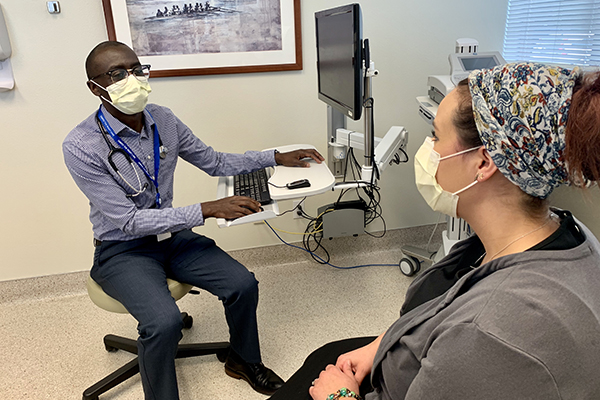Becoming better
 PacMed doctor explains how to safely reset and make lasting health-related changes
PacMed doctor explains how to safely reset and make lasting health-related changes
Now that we’ve officially bid adieu to the holiday season and all of the glorious indulgences that accompany it, many may be looking for ways to reset with a sense of healthy, lasting purpose. For some, incorporating new wellness habits may seem a daunting task at first. Thankfully, Pacific Medical Centers’ Internal Medicine Physician Lesley E. King, MD, is on the scene to address best practices for living a life of overall wellness, beyond the New Year.
Though many people enter the New Year with a newfound sense of dedication to their health and wellness goals, some may find themselves overwhelmed or tempted to cut corners in order to see fast results. What are some suggestions for easing into new healthy regimens safely?
Start small! Many times we are inspired by the New Year to make lofty resolutions to overhaul our lives. While the sentiment is wonderful, it’s not usually realistic and can set us up for failure and frustration. Instead of trying to make drastic changes — like resolving to exercise more by going from not running at all to running five days per week — build up from small changes. So for that inspired runner, they could start by setting aside time to walk or jog one or two days a week and build from there.
And, start off safe! Before making big changes to your health routine, make an appointment with your primary care physician to discuss. Not only can they give guidance on the safest way to making changes in the context of your health as a whole, but they can also be a great ally and sounding board as you make changes.
In your profession, what health concerns do you wish people would prioritize more often?
At Pacific Medical Centers, we often see patients focusing too much on the numbers and less on sustainable behavior change. Things like regular exercise, a healthful diet, sticking to recommended limits for alcohol intake, etc. can have big impacts on our quality and quantity of life which we may not always see in the numbers we can easily measure.
What are some easy ways to incorporate lasting, lifelong changes into daily life?
Be patient and kind with yourself. You didn’t gain the weight or form the habit in one day, one week, or even one month, so it’s unrealistic to expect that you’ll be able to completely change things in a short amount of time. Set small goals for the short term and celebrate your victories along the way. Finally, try and make changes that work for who you are — your interests, your passions, and your goals.
What advice can you offer to individuals who hit plateaus or are suffering from a lack of motivation?
Never underestimate the power of community and accountability. Let your loved ones know what your goals are so that they can support you. Or better yet, find a friend, family member, colleague, or another community member with similar goals. You can work together to motivate. Lots of local gyms, weight loss groups, or other community organizations have programs to connect you to peers for support.
Is there anything else you would like readers to know about incorporating lasting healthful habits into their lifestyle?
Again, your primary care physician is a great ally to have! Consider scheduling appointments at Pacific Medical Centers with their primary care team at regular intervals while you’re working on making a change. This can not only provide a bit of accountability, but can be a great opportunity to track your progress, discuss hurdles, and forge a path forward.
Health Care in the Age of Coronavirus
 There have been mixed political messages on how COVID-19 is spread but this much is not in dispute by health experts— it is very contagious, and people are advised to limit exposure wherever and whenever possible. No wonder, then, that telehealth is an increasingly popular way to access medical care, especially for the most vulnerable populations.
There have been mixed political messages on how COVID-19 is spread but this much is not in dispute by health experts— it is very contagious, and people are advised to limit exposure wherever and whenever possible. No wonder, then, that telehealth is an increasingly popular way to access medical care, especially for the most vulnerable populations.
While non-experts use the words telehealth and telemedicine interchangeably, they are not the same. According to the American Academy of Family Physicians, “telemedicine is the practice of using technology to deliver care at a distance. A physician in one location … to deliver care to a patient at a distant site. Telehealth refers broadly to electronic and telecommunications technologies and services used to provide care and service at a distance.” It’s important to note that during the coronavirus pandemic, the Centers for Medicare & Medicaid Services lifted some limitations on telehealth reimbursements.
Simon Katumu, a primary care provider with Pacific Medical Centers (PacMed), notes a definite rise in this model of care. “During the pandemic, we’ve used telehealth much more, utilizing tools such as telephone consultations, Zoom meetings, and PacMed’s MyChart.” The latter offers online access to a variety of services including test results, prescription renewals, and virtual appointments with a health-care provider.
The benefits of using these tools are clear. “They help reduce exposure in the pandemic and are also convenient,” says Katumu. “We’ve seen great benefits for our patients.”
He says that initially, the thought was that older patients may not warm up to this technology but that hasn’t been the case. “They can do it or get assistance from someone who’s tech-savvy. It hasn’t been much of a problem.”
Katumu acknowledges there are limitations to tech. “We can’t draw blood virtually. We can’t complete physical examinations, like listen to hearts and lungs. So, it’s not a replacement for face-to-face care but it is a great addition to our toolkit.”
Security is also an issue when sharing sensitive medical information remotely. PacMed is partnering with Providence to use a dedicated, secure portal for patient visits through Zoom. The enhanced measures include encryption, meeting identifications, and verification to ensure that the patient’s telehealth visit is a private and secure experience. Even so, patients are advised to have secure systems at home and to find out what security measures are in place with their particular health care providers.
Another model of care that reduces trips to the doctor is mobile urgent care. “We like to say we’re bringing back the house call,” says Valerie Rose, community engagement manager with DispatchHealth, a new company in Washington state that provides advanced medical care for urgent and non-emergency medical needs. “We do an initial risk-assessment by phone,” she explains. “Within 90 minutes a care team arrives, which includes a physician’s assistant or nurse practitioner along with a medical technician.”
DispatchHealth offers a variety of services to all ages, from flu shots to stitches, and is especially appealing to older folks, Rose says. “There is no travel, no exposure, and most services are covered by insurance, Medicare, and Medicaid.”
Plus, there’s the luxury of time. “When was the last time you had 45 minutes of undivided attention with a medical provider?”
In addition, doctor referrals are not needed and it’s not as expensive as a trip to the emergency room. “We are a great adjunct to primary care,” says Rose. DispatchHealth is currently testing and exploring telehealth options in select markets to expand their house call model.
As devastating as COVID-19 is, it has driven innovative ways in which people access medical care. And the genie is unlikely going back in the bottle.
“I do think it’s here to stay,” says PacMed’s Katumu. “I think we’ll maintain what we have at this point and I expect it will grow and expand in the future.”
Kids Summer Social Distancing
Dr. Alkharouf has some good advice for children and their parents on how to cope with social distancing this summer.
Keeping safe from COVID? Share it with #MyMaskIs!

As COVID-19 cases continue to rise across the nation, we must stand in solidarity and lead by example. At PacMed, we believe it’s our job to mask up, be #COVID smart, keep our communities safe during these turbulent times. We know to wear a face-covering or mask, hand washing and physical distancing are the best tools we have to slow the spread of COVID19. We KNOW data, science, and facts will help us beat COVID-19. Now is the time to take action and speak out about the importance of wearing a mask during this pandemic. Together, we can stand united to achieve health for a better world.
We’re asking people who are as passionate as we are to spread the message. We’d love for you to post a photo or video of you in your mask telling people why wearing a mask matters to you and use the tag #MyMaskIs and any supplemental tags you wish, such as #COVID19 #StopTheSpread #StopCOVID #pandemic.
Here is how you can join the movement:
Post on Facebook, Instagram or Twitter if you prefer a photo of you in your mask telling people why wearing a mask matters to you and use the tag #MyMaskIs along with any others. Tag @PacificMedicalCenters and @Providence for Facebook, @PacMedWA and @Providence for Twitter or @providencehealthsystem for Instagram in your post for us to see it!
Here’s an example to get you started!
I’m asking you all to wear your #mask because it makes a difference. #MyMaskIs my way of protecting my 76-year old father with cancer. Thanks to @PacMed for helping us understand if we all wear masks, together we decrease the spread by nearly 97%!!! Share what your mask means to you by using #MyMaskIs in your post. #covid19 #mask #staysafe #pandemic #stopthespread #providencecares #healthforabetterworld @providencehealthsystem
Tahini Stuffed Dates
 Want something just a little different for dessert to wow your guests? Try this unique salty/sweet combination full of fiber, protein and healthy fats! Don’t like tahini? Substitute a nut butter (peanut, almond, cashew).
Want something just a little different for dessert to wow your guests? Try this unique salty/sweet combination full of fiber, protein and healthy fats! Don’t like tahini? Substitute a nut butter (peanut, almond, cashew).
Carrot & Apple Muffins
 These delicious muffins could be served for dessert or breakfast! And why not add a serving of vegetables to this tasty treat.
These delicious muffins could be served for dessert or breakfast! And why not add a serving of vegetables to this tasty treat.
Caramelized Bananas
Your guests will love these bananas, caramelized on the outside yet soft as pudding on the inside.
Vegetarian Holiday Loaf
When meat just isn’t your thing, try this entrée at your next holiday gathering for a new meatless tradition.
Spicy Green Beans
 Add some spice to your life with this amazing green bean recipe.
Add some spice to your life with this amazing green bean recipe.
Pumpkin Sage Biscuits
A delicious and healthy twist on your regular biscuit.












